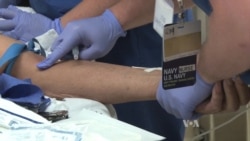New research by the University of California Davis finds that university hospital trauma centers provide the best experience for military surgeons who will someday be working in a combat zone. The U.S. Navy is training select groups of its medical staff at one of the busiest emergency departments in the country.
This is the emergency department at Los Angeles County University of Southern California Medical Center. It's a level 1 trauma center equipped to handle the worst injuries.
It is also home to the Navy Trauma Training Center, where Navy nurse Jessica Naranjo is getting 21 days of intensive training before being deployed to a combat zone.
“It’s like the shock and awe of medicine. So you see a mannequin that has a large blast wound, you know it’s a piece of plastic, you see a human come in through LA County’s emergency room with a gunshot wound and bowel hanging out, it gives us a different sense of urgency," said Naranjo.
From shootings and stabbings to major car accidents, an average of 20 serious wounds and injuries arrive here daily.
Lieutenant Commander David Donahue, a general surgeon in the Navy, says in trauma care you often only have minutes to act.
“Being able to do things in a moment’s notice without preparation, not knowing what you’re going to get into, being able to react quickly to that," said Donahue.
Valuable skills for these Navy surgeons, nurses, and hospital corpsmen.
Corpsman First Class Alex Bransdorf says the training prepares him to be in a certain mindset.
“You have to be able to think and react," said Bransdorf. "A lot of times if you have a patient who has a stab wound to the abdomen, you got to think “are they bleeding?” Do you have to get them to the OR [operating room]? What do you need to do?”
The Navy Trauma Training Center was established in 2002, but the idea dates back from data on how the wounded were cared for in the 1991 Gulf War, said Navy Trauma Training Center emergency physician Commander Jeff Ricks.
“As a military as a whole, we didn’t do a great job of providing effective trauma care efficiently in a limited resource environment," said Ricks.
He says to be more effective during combat, military medical staff need to get more trauma experience before deploying to a conflict zone.
“In peacetime operations you don’t have that exposure to the trauma medicine that is required," he said.
But there are only three training centers like this one for the U.S. military. Many people in the military medical community would like more partnerships with university level-1 trauma centers.
”It decreases that adrenaline, that adrenalin response, and allows us to keep a cooler calmer head inside the actual trauma environment," said Naranjo.
A skill Naranjo expects to use when she arrives in Afghanistan.






